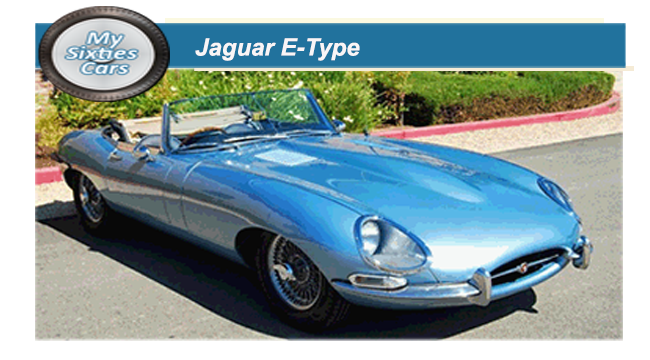
To auto historians, no other car signified all that was positive about the UK automobile industry of the Sixties than the Jaguar E-Type
Without a doubt the most charismatic of all Jaguar's new models launched in the early part of the decade, the E-Type was lighter, smaller, faster and altogether more beautiful than the XK 150s it replaced.
Initially introduced in March 1961 for export only, the early E-Types were fitted with a 3.8-litre engine came as either an open two-seater, with a removable hardtop option or fixed-head coupe.
The E-Type combined a central steel monocoque tub with a tubular front section to support the engine and gearbox, front suspension, steering and cooling radiator
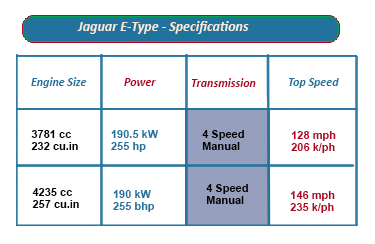 Like the D-Type, from which it was distinctly evolved, the E-Type reportedly received its styling of quite breathtaking balance and beauty as a result of the extensive mathematical analysis carried out by Jaguar's legendary designer, Malcolm Sayer.
Like the D-Type, from which it was distinctly evolved, the E-Type reportedly received its styling of quite breathtaking balance and beauty as a result of the extensive mathematical analysis carried out by Jaguar's legendary designer, Malcolm Sayer.
L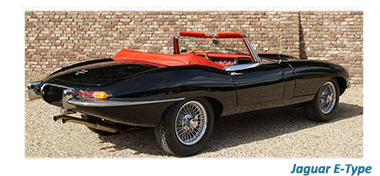 ike the Mark X saloon, launched at much the same time, some potential buyers found the original E-Types to be a little underpowered.
ike the Mark X saloon, launched at much the same time, some potential buyers found the original E-Types to be a little underpowered.
This meant that by 1964 Jaguar began to offer the car with the same definitive 4235cc engine fitted in the Mark X which was capable of conjuring up around, 265bhp —with significantly more torque.
The E-Type was the very first Jaguar to use a new, all-synchromesh, four-speed gearbox, allied to a diaphragm clutch, which a Lockheed vacuum brake servo replacing what had proved to be less than satisfactory Kelsey-Hayes unit fitted in the 3.8 litres,
Although by nature, the E-Type's cabin was cramped, with no space wasted, Jaguar found a way to introduce driver and passenger seats that were much larger and slightly more comfortable.
![]()
Driving an E-Type was as much about looking good, driving hard than passenger comfort
It was on the outside that the E-Type shone.
L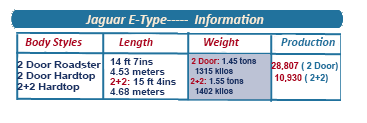 ong and sleek, with headlamps were hidden behind shaped glass shields, and the bumpers were fixed directly to the body panels, which made them decorative rather than useful.
ong and sleek, with headlamps were hidden behind shaped glass shields, and the bumpers were fixed directly to the body panels, which made them decorative rather than useful.
Centre-lock wire spoke wheels came fitted as standard.
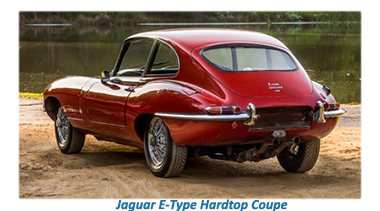 Appeals from the rapidly growing band of E-Type followers, for a roomier car were answered by a two-plus-two version in March 1966 with the announcement of the impending release of a `stretched' E-Type 2+2, with 9 inches added to the wheelbase designed to make room for two occasional rear seats under a raised coupe roofline.
Appeals from the rapidly growing band of E-Type followers, for a roomier car were answered by a two-plus-two version in March 1966 with the announcement of the impending release of a `stretched' E-Type 2+2, with 9 inches added to the wheelbase designed to make room for two occasional rear seats under a raised coupe roofline.
With a much larger windscreen, the two +two took on a lopsided appearance, losing the exquisite balance between its short waist and a low roof that designer Malcolm Sayer and his team had painstakingly engineered in the original two-seater models.
However, for the E-Type enthusiast with a small family, the 2+2 was as good a compromise that would ever be available, with the car's plush upholstered rear seat's squab providing a comfortable ride for passengers, as long as they were not too tall.A bonus was that the bolster could be readily moved forward to provide considerable luggage space, easily accessible through the wide-opening tailgate.
![]()
At the same time changes were made to the fascia/instrument/switchgear layout.
The 2+2 also had a more raked windscreen fitted with two wipers in place of the original three.
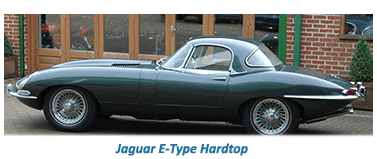 Power-and-Rack steering was available as an optional system, a Saginaw collapsible cage appeared in the steering column, and further optional equipment included chromed pressed steel disc wheels.
Power-and-Rack steering was available as an optional system, a Saginaw collapsible cage appeared in the steering column, and further optional equipment included chromed pressed steel disc wheels.
The E-Type Series 2 followed in 1968, retaining the 4.2-litre engine and all three body styles. Modifications towards the end of Series 1 were extended to meet US regulations, which also required the triple-cart UK engine to be detuned.
Sadly this legislation meant that the E-Type's headlights had to do without their by now iconic glass covers and wraparound rear bumper which detracted considerably from the charm of the vehicle.
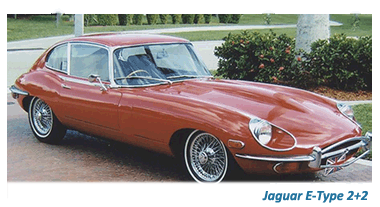 After the excitement of the early Sixties, the compromises that needed to be made tarnished the purity of its styling with fussy open lights and strangled its power with emission controls, meaning that by the end of the decade the car was a shadow of its youthfully vigorous former self.
After the excitement of the early Sixties, the compromises that needed to be made tarnished the purity of its styling with fussy open lights and strangled its power with emission controls, meaning that by the end of the decade the car was a shadow of its youthfully vigorous former self.
Even in this less than desirable format, the E-Type remained in production till the mid- Seventies.
During its close to fifteen-year production, more than 70,000 E-types were sold in its various formats, many of them going on to become collector's items, ever increasing in value
In 1975 the Jaguar E-Type was replaced by an entirely different type of sporting Jaguar, the larger, heavier and nowhere near as seductive XJ-S.






